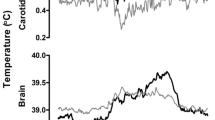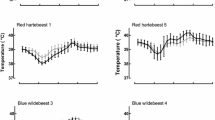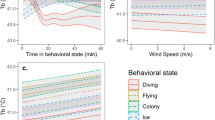Abstract.
Using implanted miniature data loggers we measured brain, arterial blood and abdominal temperatures at 5-min intervals in two free-ranging eland (Tragelaphus oryx) in their natural habitat. The animals were subjected to a nychthemeral range of globe temperature which exceeded 40 °C. Arterial blood exhibited a moderate amplitude (2.3 °C) nychthemeral rhythm, with a temperature peak at 1600–1800 hours, and a trough in the early morning at 0600–0800 hours. Mean abdominal temperature was 0.2–0.3 °C lower than the corresponding blood temperature, and had a peak-to-trough amplitude of 2.6 °C. Brain temperature closely paralleled changes in blood temperature but usually exceeded blood temperature by about 0.5 °C. Sporadic episodes of selective brain cooling occurred in one animal, but the duration and magnitude of such cooling was small (less than 0.4 °C), and took place only well above the mode of blood temperature. Our results do not support the concept that eland routinely employ adaptive heterothermy and selective brain cooling to survive in their natural environment.
Similar content being viewed by others
Author information
Authors and Affiliations
Additional information
Received after revision: 21 June 1999
Electronic Publication
Rights and permissions
About this article
Cite this article
Fuller, A., Moss, D., Skinner, J. et al. Brain, abdominal and arterial blood temperatures of free-ranging eland in their natural habitat. Pflügers Arch – Eur J Physiol 438, 671–680 (1999). https://doi.org/10.1007/s004249900105
Received:
Accepted:
Issue Date:
DOI: https://doi.org/10.1007/s004249900105




